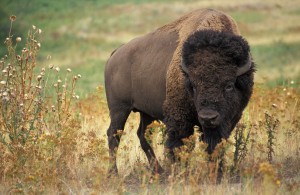American Bison (Bison bison)

American Bison (Bison bison) image from the Agricultural Research Service, U.S. Department of Agriculture.
Once thriving in untold numbers on the Great Plains, the American bison was nearly hunted to extinction by 1890. Only 541 bison survived in North America when a few ranchers collected remnants of existing herds to prevent their extinction. The bison’s main food is grass. Bison grazing increases the proportion of forbs in grasslands and increases plant diversity. Some ranchers interbred bison with cattle to produce “beefalo” leaving only four true genetically pure American Buffalo herds remaining today. Some ranchers are currently using DNA testing to cull residual residual cattle genes from their bison herds. In Kansas, two excellent locations to view bison are the Maxwell Wildlife Refuge near McPherson State Fishing Lake and Finney Game Refuge south of Garden City, Kansas. The Finney Refuge is on sandsage prairie and remains one of the few tracts of native sandsage prairie not converted to irrigated cropland. Several tall grass species thrive there including sand bluestem, giant sand reed and sand love grass. These tall grasses plus sand sagebrush makes this ecosystem truly unique. There are also approximately 16 bison at Tallgrass Prairie National Preserve in the Flint Hills of Kansas. These bison came from the genetically pure herd at Wind Cave National Park in South Dakota.
